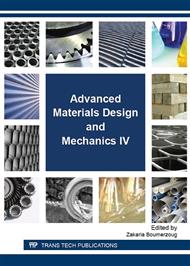[1]
T. A. Stolarski, Rolling Contact Fatigue of Polymers and Polymer Composites, Advanced in Composite Tribology edited by K. Friedrich, Elservier, 1993, Chapter 17.
DOI: 10.1016/b978-0-444-89079-5.50021-0
Google Scholar
[2]
T. A. Stolarski, Tribology of polyetheretherketone, Wear, 158, (1992) 71-78.
Google Scholar
[3]
K. Friedrich, Z. Lu and A. M. Hager, Overview on polymer composites for friction and wear application, Theoretical and Applied Fracture Mechanics, 19, (1993), 1-11.
DOI: 10.1016/0167-8442(93)90029-b
Google Scholar
[4]
M. Harrass, K. Friedrich, A. A. Almajid, Tribological behavior of selected engineering polymers under rolling contact, Tribology International, 43, (2010), 635-646.
DOI: 10.1016/j.triboint.2009.10.003
Google Scholar
[5]
K. Friedrich, G. Theiler and P. Klein, Polymer composites for tribological applications in a range between liquid helium and room temperature, In: SinhaSK, BriscoeBJ, editors. Polymer Tribology, London UK: Imperial College Press, (2009).
DOI: 10.1142/9781848162044_0011
Google Scholar
[6]
Y. Yamada, Investigation of transfer phenomenon by X-ray photoelectron spectroscopy and tribological properties of polymers sliding against polymers, Wear, 210, (1997), 59-66.
DOI: 10.1016/s0043-1648(97)07359-6
Google Scholar
[7]
DearnKD, KukurekaSN, WaltonD., Engineering polymers and composites for machine elements. In: SinhaSK, BriscoeBJ, editors. Polymer Tribology. London UK: Imperial College Press; (2009), 470-505 [Chapter 14].
Google Scholar
[8]
G. Zhang, W. Y. Lia, M. Cherigui, C. Zhang, H. Liao, J. M. Bordes, C. Coddet, Structures and tribological performances of PEEK (poly-ether-ether-ketone)-based coatings designed for tribological application, Progress in Organic Coatings, 60, (2007).
DOI: 10.1016/j.porgcoat.2007.06.004
Google Scholar
[9]
G. Zhang, H. Liao, M. Cherigui, J. Paulo Davim, C. Coddet, Effect of crystalline structure on the hardness and interfacial adherence of flame sprayed poly (ether–ether–ketone) coatings, European Polymer Journal, 43, (2007), 1077–1082.
DOI: 10.1016/j.eurpolymj.2006.12.039
Google Scholar
[10]
S. Bahadur, The development of transfer layers and their role in polymer tribology, Wear, 245, (2000), 92-99.
DOI: 10.1016/s0043-1648(00)00469-5
Google Scholar
[11]
S. Bahadur, D. Gong and J.W. Anderegg, The investigation of the action of fillers by XPS studies of the transfer films of PEEK and its composites containing CUS and CUF2, Wear, 160, (1993), 131-138.
DOI: 10.1016/0043-1648(93)90414-h
Google Scholar
[12]
H. Koike, K. Kida, E. C. Santos, J. Rozwadowska, Y. Kashima and K. Kanemasu, Tribology International, 49, (2012), 30-38.
DOI: 10.1016/j.triboint.2011.12.005
Google Scholar


